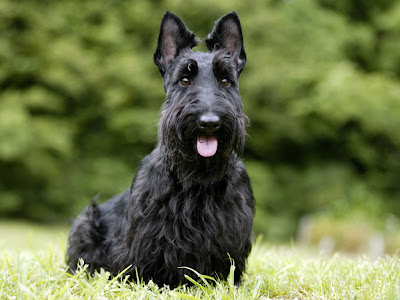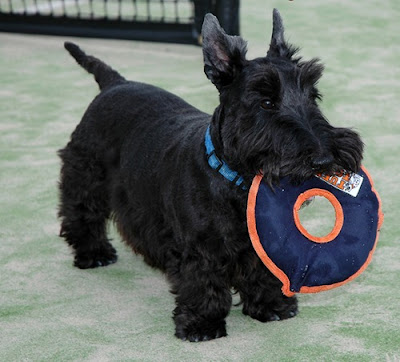In the old days of the Scottish clans, utility rather than beauty was the requisite attribute of the Scottish Terrier. To hunt across the moors, Scottish mountaineers wanted dogs of action and adaptability first and companionship second. As one early writer wrote in 1834, “he is of great service to man on account of his great hostility to rats, mice, polecats and such animals. He shows wonderful power in killing rats...as many as 100 in seven minutes.” Because of the mountainous terrain of Scotland, the isolation and segregation of Scottish clans and the lack of transportation, the Scottish Terrier was little known outside of the confides of the Scottish highlands until the mid 1800s.
In the mid 1800s, several factors came together that helped to transport the Scottish Terrier from working terrier to companion of royalty, presidents, and authors as well as the working man. First, transportation improved significantly with trains and better highways transcribing the south and north of England and Scotland. This allowed the transport of these hardworking Scots of “sandy, black or brindle” color. Facing religious differences, thousands of Scotsman traveled to Ireland, taking along with them their national dog.
More importantly, Queen Victoria became familiar with the dogs of Scottish lowlands during her frequent travels to her castle in Scotland with her beloved husband Prince Albert. A dog lover all her life, she fell in love with the dogs of the Scottish moors and added them to her expansive kennels in Scotland and England. Upon the death of Prince Albert in 1861, the Queen took to seclusion preferring to surround herself with canine companions. It was at this juncture, the Scottish Terrier like other notable canines of the period became companions of the court, rather than mere barnyard servants. She raised in her lifetime more than 15 different breeds of canine, notwithstanding Skye Terriers and Scottish Terriers. Her favorite Scot was named Laddie.
She was particularly fond of silver brindle Scottish Terriers, so much so that breeders would give her their silver Scots to remain in her good favor. Because she was not into the breeding the dogs, the color became more rare than it was at the time.3 It is said that she refused to recognize even the remote possibility that “her dogs might copulate and offend royal sensibilities.” While no pictures could be found of the queen with any of her Scottish Terrier, she is shown here in a portraiture as a young woman with a Manchester terrier and in the second picture with some of Skye Terriers.
Another early aristocrat to be enamored with Scottish Terriers was George, fourth Earl of Dumbarton. George had a famous pack of Scottish Terriers so brave and intrepid they were called the diehard, hence the term we use today. They were the inspiration of the name of his regiment, The Royal Scots, Dumbarton’s “Diehards.”4 The Royal Scots, the oldest Infantry Regiment of the Line in the British Army, was formed in 1633 when Sir John Hepburn under a Royal Warrant granted by King Charles I, raised a body of men in Scotland for service in France. George’s battalion saw action in the late 1800s.
Like other terriers, the Scottish Terrier rose to prominence as a favored breed of the rich and powerful in the 1930s. One of the most notable families of the time were Charles and Anne Morrow Lindburghs. He was the handsome aviator andshe was the famous author. On May 20, 1927, Charles Augustus Lindberg became a world hero. He was the first aviator to fly across the Atlantic Ocean in a solo flight. The Lindbergh's owned two Scottish Terriers and two West Highland White Terriers. Their Scotties were named Skean and Bogey and their Westies were named Peter and Pim.
The Lindburgh’s attained further prominence when their 20 month old son, Charles Junior disappeared from his crib in 1932. Charles Junior is shown in the attached pictured with the family’s Scotties and Westies in 1931. After receipt of numerous ransom notes, $50,000 in cash was handed over to a man in a Bronx cemetery known only as “John.” On May 12, 1932 the child's decomposed body, lying in a shallow grave only two miles (walking distance) from his home, was found by a truck driver. The baby had been dead since the night of his disappearance. Lindbergh, who lead the investigation from its inception, ordered an immediate cremation. No legitimate autopsy was ever performed.
Across time, superstition has played an important role in keeping the spirits of soldiers high during times of war. World War II was no exception particularly for one team of flyboys. lead by 24-year-old Captain James Morgan, the B-17 Flying Fortress "MEMPHIS BELLE" was the first heavy bomber in Hitler's European war theatre to complete 25 combat missions and keep her entire. crew alive The mascot of this daredevil group of American flyers was of course, a Scottish terrier by the name of Stuka. Upon returning from each mission the wee dog was there waiting for the brave team to return.
Another American president to be owned by a series of Scottish Terriers was Dwight D. Eisenhower. Eisenhower’s devotion to the breed predates his presidency and traces back to his loneliness during World War II. The demands of being commander in chief were sometimes overbearing. Attempting to gain a little peace and quiet as well as time to think, Ike moved out of central London to picturesque Telegraph Cottage, a forty-minute drive from Grosvenor Square. Telegraph Cottage was set back from the main road at the end of a long driveway, had a large garden at the front and ten acres of woodland at the back. Best of all, perhaps, it was adjacent to a golf course. It was the perfect retreat.















0 comments:
Post a Comment